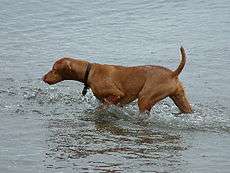Hungarian animals

A Vizsla
The Hungarian breeds of domestic animals are often seen as national symbols in Hungary. Local national parks serve as "gene banks" to ensure their survival.
- Long-horn Hungarian Grey Cattle- Hungarian breed, traditionally kept in the open full year. Nowadays they are raised for infant food due to natural, healthy meat.
- Magyar Vizsla - one of the oldest hunting dogs of the world. The ancestors of this dog came into the Carpathian Basin with the nomadic Hungarian tribes.
- Hungarian Puli - small shepherd dog
- Hungarian Komondor - a very large livestock guardian and shepherd dog, was brought to Hungary a thousand years ago by nomadic Magyars.
- Hungarian Kuvasz - large shepherd dog.
- Hungarian Pumi - small shepherd dog.
- Hungarian Sighthound is already known in the 8th century, it is as old as the Vizsla.
- Transylvanian Bloodhound - Hungarian hound, a hunting dog.
- Hungarian Mudi small shepherd dog.
- Hungarian thoroughbred horses - a mid-19th century mixture of the best Arab and English race horse characteristics.
- Nóniusz horse
- Lipizzan, the mostly white breed of heavy cavalry horses, originated from Slovenia and successfully bred in Hungary.
- Mangalitsa, a breed of pigs, characterised by their long curly hair and relatively fatty meat which makes them ideal for making sausages and salami.
- Racka - a breed of sheep with distinctive horns.
- Hungarian buffalo
- Hungarian mottled cattle or Hungarian red mottled cattle
- Hungarian hen
- Hungarian turkey
- Hungarian wasteland 'parlagi' donkey
- Hungarian wasteland 'parlagi' goat
- Transylvanian Naked-neck chicken
- Hungarian geese
- Cikta sheep
- Cigája sheep
- Hungarian duck
- Pearl hen
- Hungarian tarsza (insect)
See also
| ||||||||||||||||||||||||||||||||||||||
This article is issued from Wikipedia - version of the Friday, November 20, 2015. The text is available under the Creative Commons Attribution/Share Alike but additional terms may apply for the media files.